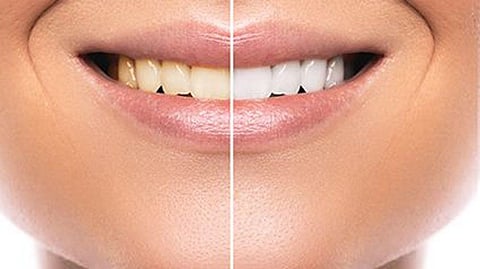TUESDAY, Sept. 7, 2021 (HealthDay News) -- Do-it-yourself dental gels promise blindingly white movie-star smiles, but new research warns that gels that rely on peroxide as their main ingredient can do serious damage to tooth enamel.
The in-depth study looked at tooth integrity following exposure to whitening gels containing varying concentrations of carbamide peroxide (CP).
CP is one of the most common active ingredients found in at-home tooth whitening products. And investigators found that even at relatively low concentrations of 10%, such products can eat away as much as half the enamel protein content found in typical teeth.
And while conducted in tooth samples -- rather than in actual mouths -- the analysis further suggests that over time such enamel degradation allows CP products to penetrate deep inside teeth, raising the risk for cell death inside the internal dental pulp core, which is critical to overall dental health.
The "whitening reaction" that gel users are looking for "is carried out by the hydrogen peroxide-derived free radicals breaking down large molecules that give the tooth its natural color," explained study author Laurent Bozec, an associate professor with the faculty of dentistry at the University of Toronto.
But that breakdown process is essentially messy, Bozec added, often expanding beyond those molecules that affect tooth color to "affect all the proteins and cells inside the tooth."
The upshot: significant enamel loss and "the degradation of the collagen that is present inside the dentine part of your teeth," said Bozec, referring to the dense bony tissue that lies beneath enamel.
And "unlike bone, this dentine does not regenerate, and once it has been damaged/denatured by the chemical process, it is lost forever," he said.
In fact, when coupled alongside damage to the dental pulp core itself the end result is a much greater long-term risk for tooth breakage and even tooth death and loss.
The laboratory tests conducted by Bozec and his colleagues involved whitening products with CP content ranging from 5% to 35%. Though there are other at-home tooth whitening products that don't use peroxide, the team noted that CP products are both popular and widely available for retail purchase at all the tested concentrations. (Specific brand names of the gels tested in the investigation were not disclosed.)
Part of the study involved exposing 30 tooth samples to four hours per day of whitening gels at a concentration of either 5% or 16% CP. After two weeks, enamel protein assessments were conducted.
The result: enamel protein content was found to be "significantly lower" after gel exposure, compared with teeth not treated with whitening gels.
In another test, the researchers exposed internal tissue extracted from 34 tooth samples to gels at concentrations of 5%, 10% and 35% CP, before conducting cell culture analyses.
The result: the higher concentration of CP exposure, the greater the amount of deep dental tissue cell death, with exposure to 35% CP leading to exponentially greater cell death than gels with lower CP concentrations.
"[So] yes, based on our findings, it is better to use as low a concentration of peroxide as possible, and use it sparingly, or use alternatives that are non-peroxide-based," advised Bozec, though he acknowledged that "by using lower concentrations of peroxide, it is likely that the 'whitening' effect would take longer to achieve a similar result."
But a slower, lower peroxide approach might be just the ticket, said Dr. John Chicvak, a practicing dentist with Northwell Health's Department of Dental Medicine in New Hyde Park, N.Y.
"This study brings to light some interesting questions on the risk to tooth health," he said. "While we have been bleaching for decades, there has been a trend towards increasing concentrations of peroxides and corresponding increases to tooth and gum sensitivities leading to persistent mouth discomfort.
"The approach with the least side effects to overall oral health and with the desired results seem to be 'low and slow,'" added Chicvak. "Low concentrations of peroxide over a longer period of time."
Still, Dr. Matt Messina, a spokesperson for the American Dental Association, says more research is needed before drawing hard and fast conclusions.
"Tooth whitening is a procedure designed to be done in a healthy mouth situation," he stressed. "I always recommend that people considering whitening have a comprehensive examination by their dentist prior to starting whitening. There are a number of reasons why teeth appear darker than a person would like, and whitening alone does not resolve many of these."
Messina pointed out that "tooth whitening has been done safely for well over 20 years without evidence of long-term negative effects," and "the study in question was a laboratory study of extracted teeth, so it is challenging to apply that directly to live teeth in the mouth."
So going forward, "we need to review these findings, and continue to study the effects of tooth whitening in actual patients," Messina said.
The findings were published online recently in the journal Scientific Reports.
More information
There's more on tooth whitening safety from the Cleveland Clinic.
SOURCES: Laurent Bozec, PhD, associate professor, faculty of dentistry, University of Toronto; Matthew Messina, DDS, spokesperson, American Dental Association; John Chicvak, DDS, dentist, Department of Dental Medicine, Northwell Health, New Hyde Park, N.Y.; Scientific Reports, July 30, 2021, online


